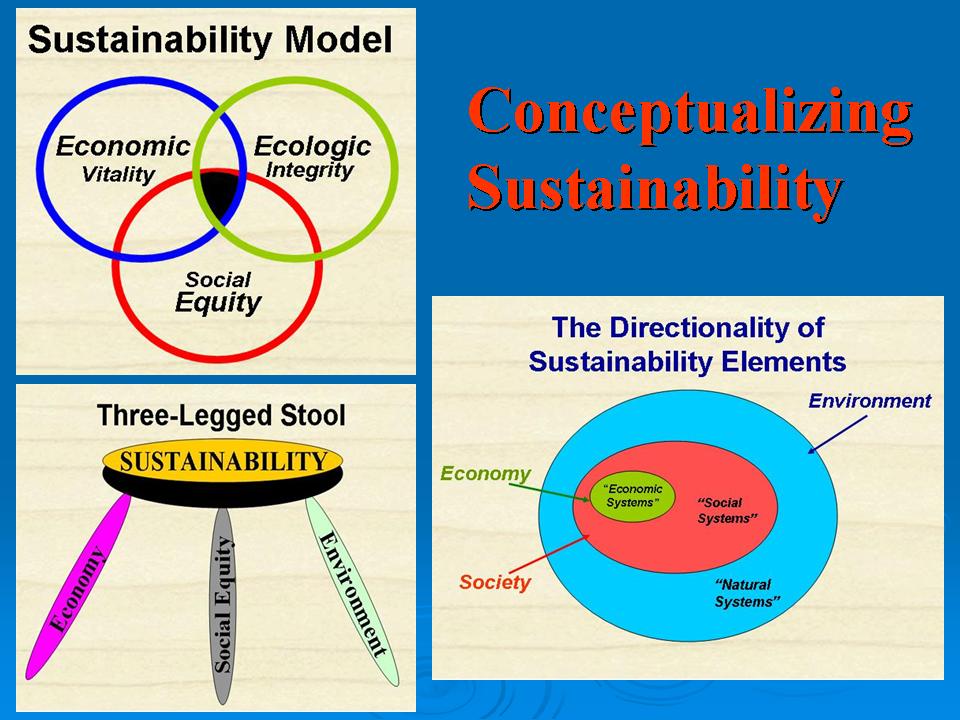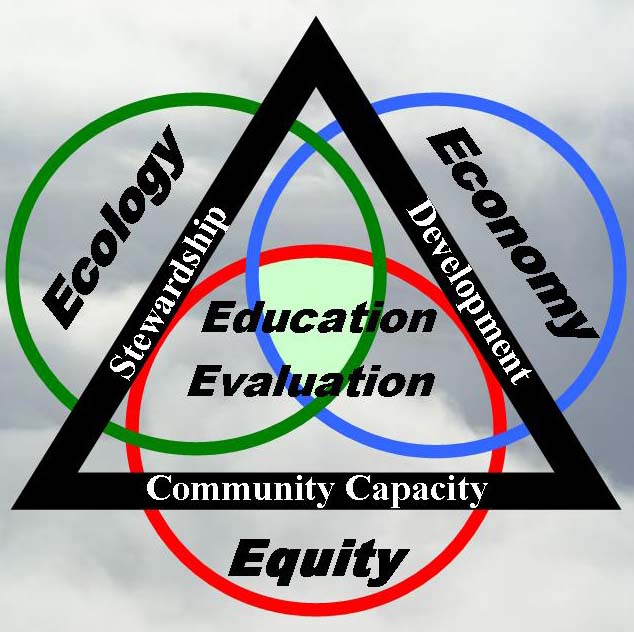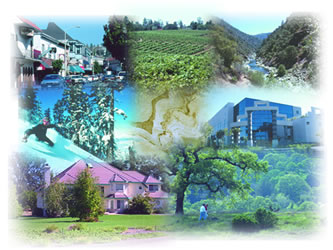What
is a Bioregion? A geographical area described in terms of
its unique combination of plants, animals, geology, climate
and water features – an area defined by natural boundaries
and distinct living communities – the whole of which
distinguishes it from other bioregions. A bioregion refers
both to geographical terrain and a terrain of consciousness – to
a place and the ideas that have developed about how too live
in that place. Thus, natural forms and living communities,
including human, become the descriptive features of each
bioregion – instead of the politically drawn lines
used to define county, state and nation. Watersheds, being
an important physical feature of bioregions, are often used
to define their boundaries, as has happened in New Zealand.
Bioregional
planning as yet has few established paradigms or
methods, but the theory and practice are beginning
to coalesce around observed regional patterns. A
bioregional scale is emerging as a meaningful geographic
framework for understanding place and designing long-term
sustainable communities. For every bioregion it is
becoming apparent there is a unique set of practices
of scientific investigation
that leads to planning, design, and management that
will result in a bioregionally unique set of landscape-human
patterns.
Awareness
and care for one’s bioregional home and its
patterns is fundamental to a place-based understanding
and community stewardship of sustainability – to
cultural and ecological well-being – living
in a place sustainable and respectfully. What bioregionalism
represents, identification with place and its history
and culture, and living within the laws of nature,
is new only for people who come out of an industrial-technological
heritage. The essence of bioregionalism has been
reality and common sense for native people living
close to the land for thousands of years. Bioregionalism
acknowledges that we not only live in cities, towns,
villages and country-sides; we also live in watersheds,
ecosystems, and eco-regions. This context allows
us to find ways to live sustainably in our settlements
while at the same time provides us ways to nurture
and restore the more-than-human community that surrounds
us and which we are dependent on in so many ways.
Bioregionalism
is taking the time to learn the possibilities of
place. It is a mindfulness of local environment,
history, and community aspirations that leads to
a sustainable future. It relies on safe and renewable
sources of food and energy. It ensures employment
by supplying a rich diversity of services within
the community, by recycling our resources, and by
exchanging prudent surpluses with other regions.
Bioregionalism is working to satisfy basic needs
locally, such as education, health care and self-governance.
The bioregional perspective recreates a widely-shared
sense of regional identity founded upon a renewed
critical awareness of and respect for the integrity
of our ecological communities.
 Lewis
(1996) described how understanding the patterns,
colors, and textures of the landscape gives a logical
order to a system, where bioregional patterns suggest
limitations and unique solutions. Once identified,
the scientific understanding gained from these ecological
patterns and spatial resources are logical form determinants – they
suggest the spatial form to guide policies toward
sustainability. For example, Lewis discovered patterns
by curiously studying composite night images of the
U.S. and imagining the concentration of lights around
cities to be regional constellations. Lewis tells
us that identifying bio-cultural regional patterns
provides solutions for where to build and where not
to build. He suggests that one can discern patterns
that diminish the quality of life, sense of place,
and sustainability, as well as patterns that enhance
these features by adopting this constellation or
bioregional view.
Thus
the act of "constellating" can direct attention
to the ever-shifting collection of biophysical and
human systems that interact to configure the bioregional
experience. Constellating is intentionally open-ended,
and requires thoughtful interpretation. As a design
activity, constellating focuses on assembling the
array of physical forms, infrastructural interconnections,
development models, and social agents needed to create
new forms of public engagement and interaction. This
perspective can help decision-makers set goals that
are within the capacities of the natural systems,
and at the same time, more likely to meet social
values for an area.
The
bioregional framework supports the goal of accelerating
change toward improved well-being for nature and
society for a number of reasons:
- Bioregionalism
identifies areas similar in transport-trade,
communication networks, natural resource reliance,
cultures, recreational desires, natural ecosystems,
governance, and societal issues of concern.
- It
makes little sense to discuss the topic of sustainability
at the global scale if insufficient thought is
given to the local places and scales where human
life actually occurs. Societal actions that are
sustainable for humans, other life-forms, and
earthly systems can best be achieved by means
of a spatial framework in which people live as
rooted, active, participating members of a reasonably
scaled, naturally bounded, ecologically defined “place.”
- Considering
problems and solutions from a bioregional perspective
offers an opportunity to engage in comprehensive,
adaptively managed change improving society’s
overall opportunity to achieve sustainability
at a scale not possible within a single community
effort. One can discern patterns that diminish
the quality of life, sense of place, and sustainability,
as well as patterns that enhance these features,
by adopting community convergence activities
or a bioregional view.
- National
and international communities of people will
have to undergo significant adaptive change to
deal with a transition from global warming. But
large-scale social change will only happen where
people share common concerns, goals, and core
values. Acknowledging that community-by-community
change is too slow, the bioregion offers an example
of where communities with common ecology, culture,
and economy can converge for a greater good.
Likewise, challenges to social change are certainly
more easily overcome in a converging of local
communities at the bioregion than by trying to
encourage action at the national level.
 Bioregions
are governed by nature not politics. So once
we understand the inherent physical, biological,
and ecologic
relationships of a bioregion, we can count on
actions judged to be sound according to the theory
of the three-legged stool or three-overlapping
circles to be much more predictable, enduring,
and supportive, as well as less costly, to society
than the unending quest to find technological
fixes for all our problems that governing bodies
can promote their next election on. Bioregions
are governed by nature not politics. So once
we understand the inherent physical, biological,
and ecologic
relationships of a bioregion, we can count on
actions judged to be sound according to the theory
of the three-legged stool or three-overlapping
circles to be much more predictable, enduring,
and supportive, as well as less costly, to society
than the unending quest to find technological
fixes for all our problems that governing bodies
can promote their next election on.- Because
of the many common threads that weave through
the landscape
tapestry of a bioregion scale, which we can personalize
by calling home, the concentric circles of environment,
society, and economy relationships become much
easier to traverse, affording us the opportunity
to leave home a little better off than we might
have found it.
- Bioregional-based
planning and action can help society narrow problems
and solutions, and help participants to acknowledge
the limitations of a place and its resources
so that they will not continue to overestimate
the carrying capacity of the regions they inhabit,
and live more sustainably.
- This
convergent, bioregional approach can influence
the larger world mainstream by its regeneration
of local cultures, ecosystems, and resources
into the indefinite future, contributing to the
more global needs of life on Earth, more effectively
than a national or global scale initiative ever
could.
- For
every bioregion, there may be a unique set of
practices, tools, models, and successes within
individual organizations that supports planning,
design, and management. Instead of “reinventing
the wheel” with each new initiative, project,
or campaign the bioregional scale of sustainability
work can enhance a transfer of knowledge and
technology for the betterment of the entire region.
The
bioregional framework represents a whole scale nature-human
linked system as a place-based approach to promote
scientific understanding, planning, and action to regenerate
our communities and other living systems.
|


